Pictures for newborn children. Black and white pictures for newborns

Read also
We offer you to download and print black-and-white and black-white-red pictures to stimulate the organs of vision in babies, which you can place in the baby's crib, on the changing table, or simply hang on the walls in the nursery.
Pictures for printing
Educational black and white pictures, 60 sheets, A4 format, PDF file. The recommended baby age is 0-2 months. 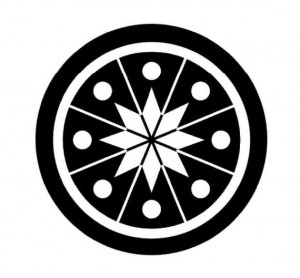
Educational black-white-red pictures, 60 sheets, A4 format, PDF file. The recommended age for a child is 2-4 months.
It is very useful for babies from birth to 3-4 months to look at contrasting black and white images for the development of vision.
A baby learns to see in the first weeks of life the world... The more visual information he receives, the more actively his brain develops. Therefore, a child, whose environment is visually enriched, is calm and attentive while awake.
The first and most important visual objects that stimulate the development of the newborn's vision are the faces of mom and dad. It is important to look at your child as often as possible, communicate with him and smile.
In second place are developing contrasting black-and-white pictures that the baby can "look at". Newborn babies love simple patterns: geometric figures, cell, strip, points, straight and broken lines.
In the next few months, the baby's brain learns to distinguish colors. He will begin to prefer bright, simple colors and more complex patterns.
How to use pictures
In the first months of life, it is important to form two visual skills: to fix and examine an object, and to trace it.
You can pin sheets of paper with black and white pictures on a crib, or place contrasting pictures on a changing table or development rug. Hang pictures on the walls of the room and show when the child is awake. This will help your baby learn to focus. Fit black and white photos mom and dad.
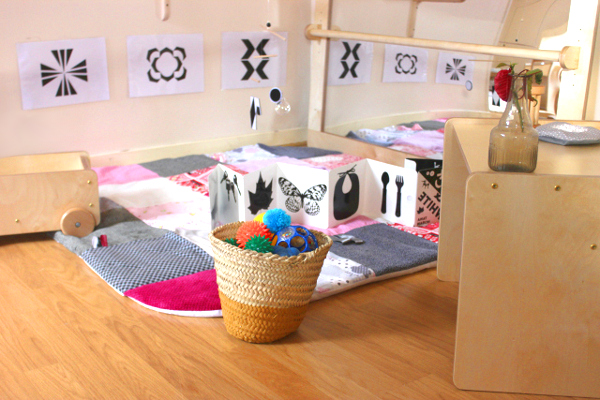
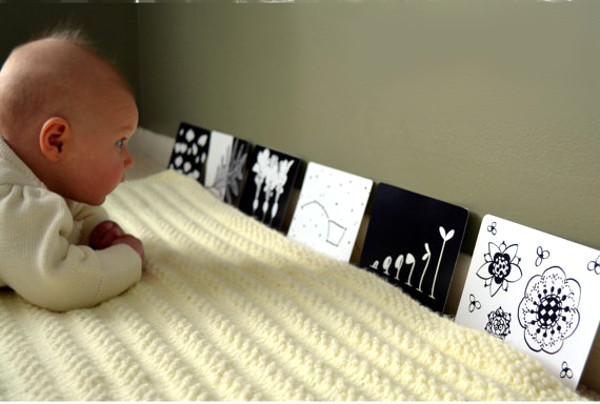
For the development of the child's vision, you can sew a soft double-sided panel with contrasting pictures from fabric or purchase it in the store (it is convenient to place it on the developing panel in the baby's crib and in the stroller. 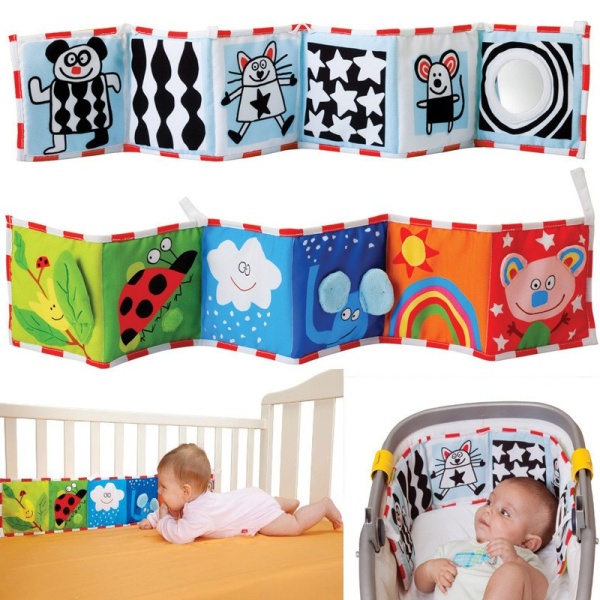
It is useful to hang a black and white mobile over the baby's bed.
We recommend the article ““.
********************************************************************
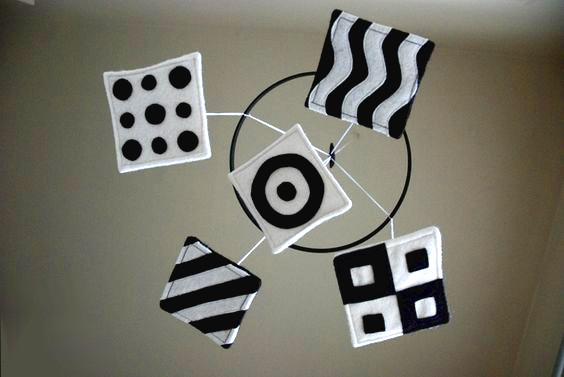
The formation of the human brain takes place in the mother's belly. And the development of the brain after birth is facilitated by the emergence of new neural connections. And visual perception in this important process is of great importance.
More than 80% of information from the world around a person receives through sight. Therefore, for a complete and harmonious development little child you need to stimulate his visual perception. How younger child, the more intensively he learns. From birth, children need new experiences, food for brain development. If the brain processes only sound stimuli, it does not work at full capacity, then it is very important to provide the child with the opportunity to see different objects as soon as possible. The child's vision develops gradually. Up to two to three months, he does not distinguish colors. For this age, clear, contrasting black-and-white pictures are best suited, which are installed at a distance of 20-30 cm from the child's eyes. You can use them for as long as they like the child and arouse his interest. Sarah Brewer's book Super Baby describes the role of black and white images in the development of babies between 0 and 3 months of age.
Excerpts from Sarah Brewer's Super Baby
Vision plays a decisive role in the development of a child. Seeing various objects in front of him, the child wants to know what it is. The desire to reach for objects, crawl, roll over comes from natural curiosity and the desire to explore everything that the child sees around him. In the first two months of his life, he sees best at close range. The field of vision of a newborn baby is more limited than that of an adult. Presumably, objects that are no further than 30 degrees to the left and right of him, 10 degrees above and below and at a distance not exceeding 90 cm from his eyes fall into the child's field of vision. When he suckles, he naturally focuses his vision on objects at a distance of 15 to 20 cm. Usually, by two weeks, the baby begins to recognize the faces of the mother and father. His visual acuity is 10 to 30 percent less than that of an adult, so it is more difficult for him to recognize fine lines that he sees as a smeared gray mass. Retina human eye contains photoreceptors such as rods and cones. Rods are cells that are sensitive to weak light and movement and only distinguish shades of black and white. Cones are cells that are responsible for daytime vision and allow you to see different colors and shades. Newborn babies prefer contrasting black and white drawings than colored ones, because at this age their rods perform better than cones. All other colors are seen by them as shades of gray. Since black and white colors are most easily recognized by children, the use of black and white pictures stimulates the formation of connections between neurons in the cerebral cortex, develops attention, spurs children's natural curiosity and soothes during periods of overexcitation. Also, newborns prefer straight or broken lines rather than curved or wavy lines. In addition, they are attracted to the simple, schematic images human faces... By the sixth week, the child can clearly focus on various objects at a distance of about 30 cm from him. He is especially attracted to simple images persons and concentric circles v different options... The child studies the outer edges of the drawings more closely than their middle. The human brain is fully formed during intrauterine development. The number of neurons does not increase after birth, the brain develops due to the formation of new connections between neurons. The number of contacts between neurons in the area of the cerebral cortex responsible for visual information begins to gradually increase in the first 2 months after birth. Between 2 and 4 months, the number of connections between neurons begins to grow sharply and increases by no less than 10 times. At this time, the child's eyesight improves dramatically, he can follow objects with his eyes and turn in the direction from which the sound comes. He starts to like it more complex drawings, rounded lines and shapes, not straight and broken lines. From the behavior of the child, you can see that he remembers what he saw. Many babies begin to distinguish colors by two months, because cones begin to work in the retina. But until three months, they presumably don't see blue color as good as yellow or red. By the age of four months, the child can distinguish all colors and can focus his vision on both near and distant objects. He enjoys watching parents and other people, especially children. He still prefers curved lines to straight lines and pays attention to more complex designs. At 4 - 5 months, the child begins to reach for objects that he sees, at 7 - 8 months he can grab objects and try to put them in his mouth. Child, visual perception which is constantly stimulated, usually more calm and alert while awake than a child without such stimulation. The number of contacts between neurons in the visual cortex peaks at 8 months of age, remains at its maximum until four years of age, and gradually decreases by half over the next five years. Consequently, binocular vision develops during the first four years of life and is fully developed by the age of four. Visual acuity is practically established by the age of five and is finally formed by the age of ten.
What pictures for newborns like the smallest - the use of pictures for the development of babies
Children are incorrigible explorers who begin to explore the world, having barely learned how to hold their heads and grab their mother's finger. The vision of a newborn is more modest than that of an adult -the baby is able to clearly see objects only at close range ... Further, visual abilities change in accordance with age. And already with them - and interest in certain pictures.
- In 2 weeks The "old" baby is already able to recognize the face of mom (dad), but it is still difficult for him to see fine lines, as well as to distinguish colors. Therefore, at this age the best way- pictures with broken and straight lines, simplified images of faces, cells, simple geometry.
- 1.5 month the crumb is attracted by concentric circles (moreover, more - the circle itself than its center).
- 2-4 months. The baby's vision changes dramatically - he already turns to where the sound is coming from, and follows the subject. For this age, pictures with 4 circles, curved lines and more are suitable complex forms, small animals (in a simple image).
- 4 months. The kid is able to focus his gaze on an object of any distance, distinguishes colors and observes the world around him. Curved lines of drawings at this age are more preferable, but it is already quite possible to use complex drawings.
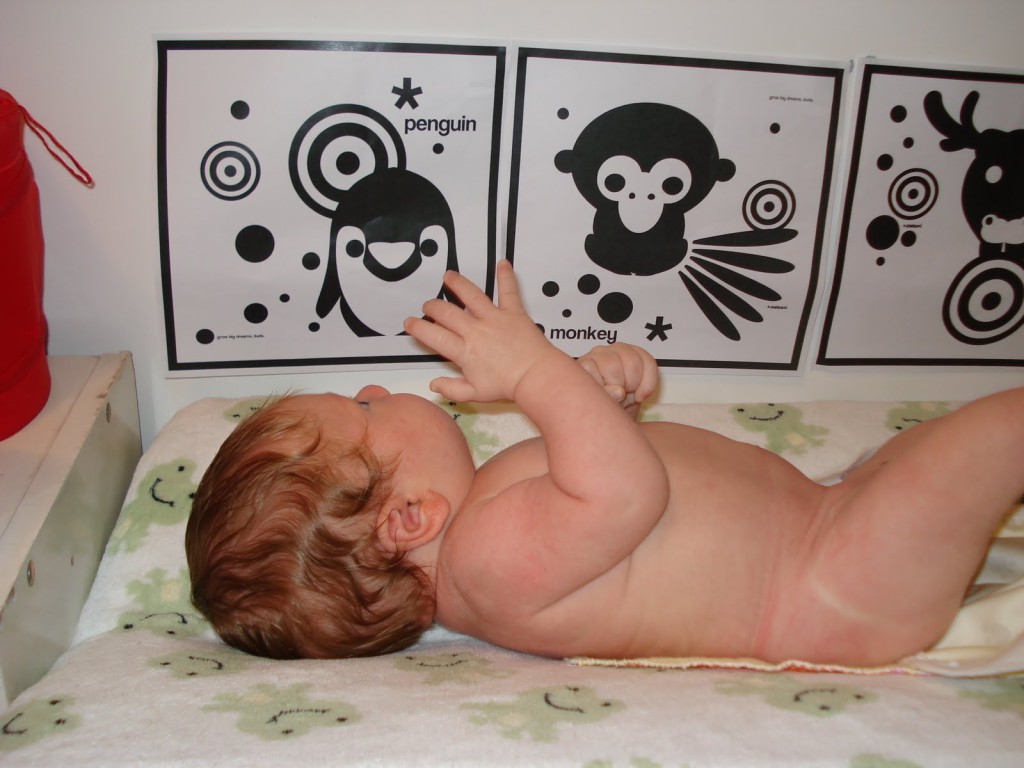
How to use black and white pictures for newborns - the first picture games for babies under one year old
- Start with the most simple lines. Watch for crisp black / white contrast.
- Change images every 3 days.
- When the baby shows interest in the picture leave her for a longer time- let the baby study it.
- Pictures can be drawn by hand on paper and hang directly in the crib, stick on walls, fridge or on large cubes. As an option - cards that can be shown to the baby one by one, a contrasting soft ball with black and white drawings, a developing rug, a book, a carousel with pictures, collages, etc.
- Show the crumbs pictures while you are walking around the apartment with him, feed him or lay him on his tummy... The visually rich space (and the constant stimulation of vision) has a direct connection with the restful sleep of the baby.
- Do not show too many pictures at once to the little one and watch the reaction. If he does not focus his gaze on the drawing and does not show interest in him at all - do not be discouraged (everything has its time).
- Distance from the child's eyes to the image at the age of 10 days - 1.5 months - about 30 cm. The size of the pictures - A4 format or even a quarter of it.
- From 4 months, images can be replace with colored, complex and "hygienically clean"- the baby will start dragging them into his mouth. Here you can already use high-quality toys with black and white drawings and cartoons for the little ones (the movement of black and white lines and shapes to the right music).
- And, of course, do not forget about such nuances of the development of visual perception as communication with the baby at a distance of 30 cm, contact with the help of smiles and "faces", exercises with rattles(from side to side, so that the baby follows her with a gaze), new impressions (excursions around the apartment with a demonstration of all interesting objects).
Practical implementation of black and white ideas
You can independently draw pictures on a white sheet of paper with a black bold marker, black gouache or ink, or print ready-made templates... Themes of the drawings:
- geometric shapes (familiarity with shapes),
- emoticons (learning emotions),
- vegetables fruits,
- silhouettes of animals and insects ( Live nature),
- just broken lines, punctuation marks, etc.
The sizes of pictures can be different, from ¼ A4 to A4 (whole sheet), because real objects that surround the child are also not the same in size. It will soon become clear which of them are more interesting for the child. You can post pictures on cardboard boxes, on boxes of perfume, light bulbs, discs and cassettes so that they can be conveniently placed in front of the child.
Pictures can be both flat (drawn on a sheet of paper) and voluminous (drawn on cylinders, cubes, etc.) Cubes can be useful later when the child grows up and will not just look at them, but play with them, study by them letters and numbers. Pictures can be static (drawn) or moving, when cut black figures (stripes, circles, hearts, butterflies, etc.) are attached to the bar in front of a white background and move slightly from any light breath. Also, pictures can be placed in the form of an overlay on the side of a crib.
There are no specific guidelines for when to move from the most simple pictures(squares, triangles, straight lines) to more complex ones. The child himself will make it clear what he is interested in, carefully examining some pictures and quickly skimming over others. It is not necessary to tape the pictures with tape, since they are intended for an age when children will not pull them into their mouths.
You can make a mobile (carousel), which is hung over the bed, from black and white pictures pasted on cardboard boxes. Some firms produce ready-made black and white toys (mobiles) and educational rugs. From four months you can replace black and white pictures on your mobile with color ones.
There are also black and white cartoons for Wee See babies, in which geometric shapes smoothly move across the screen and flow into each other with beautiful melodic music.
3.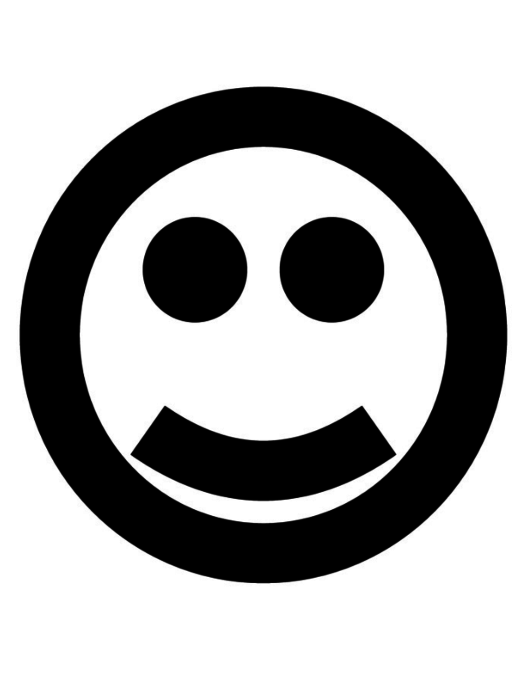
4.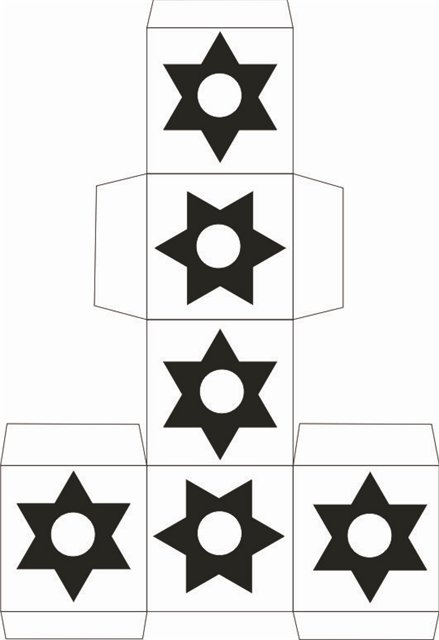
5..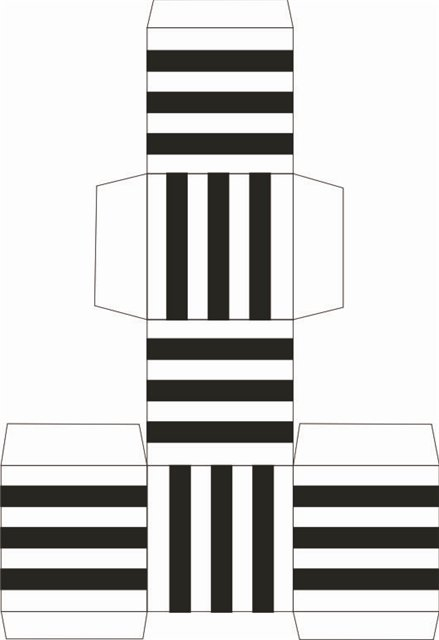
6.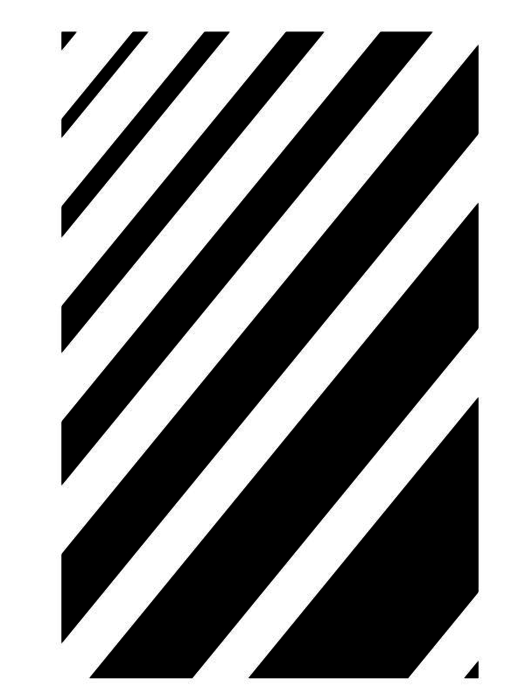
7..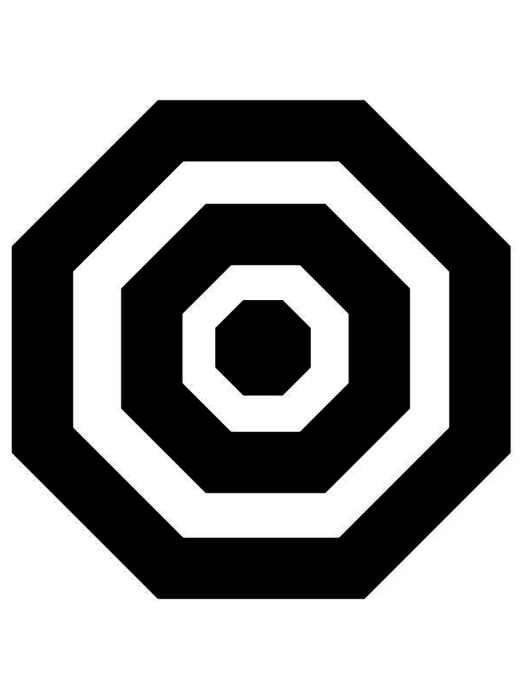
8.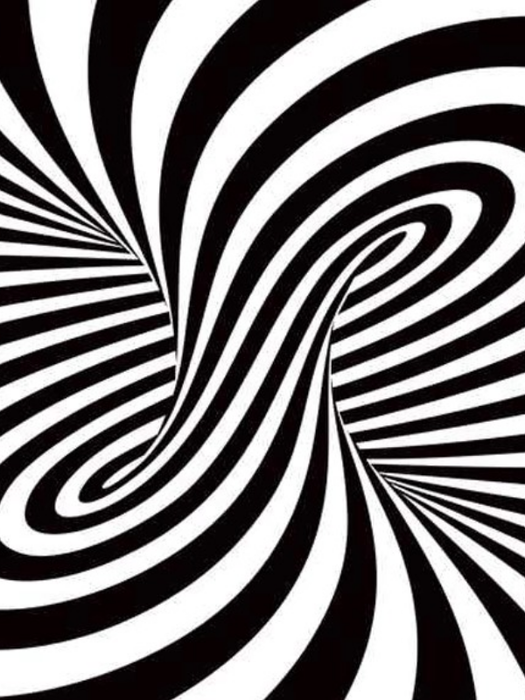
9.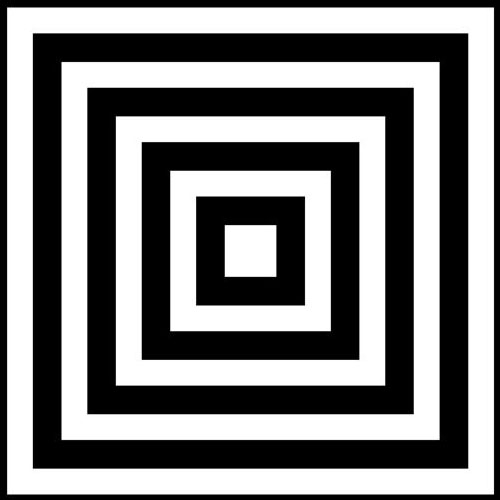
10.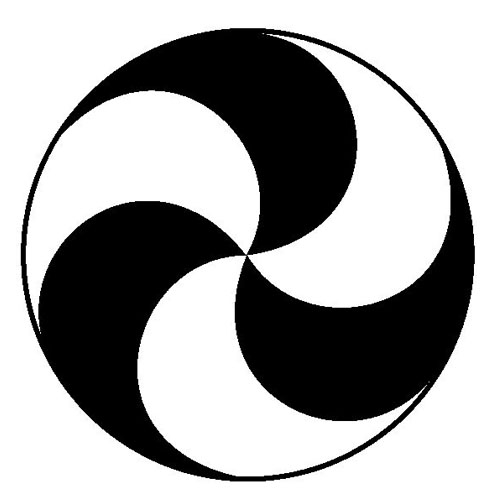
11.
12.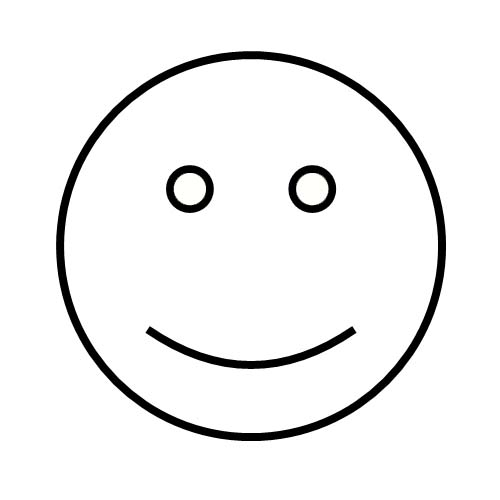
13.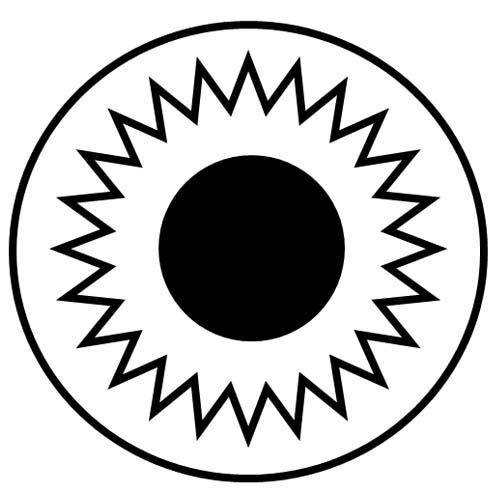
14.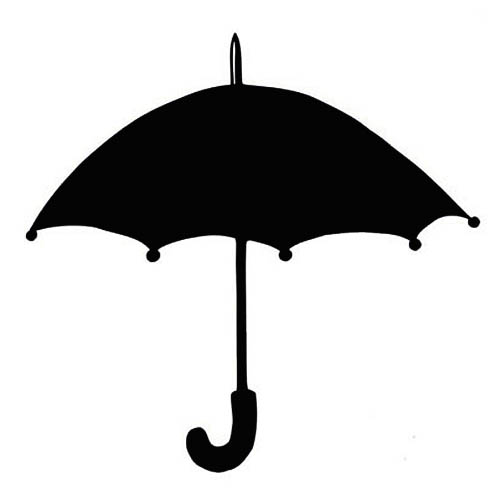
15..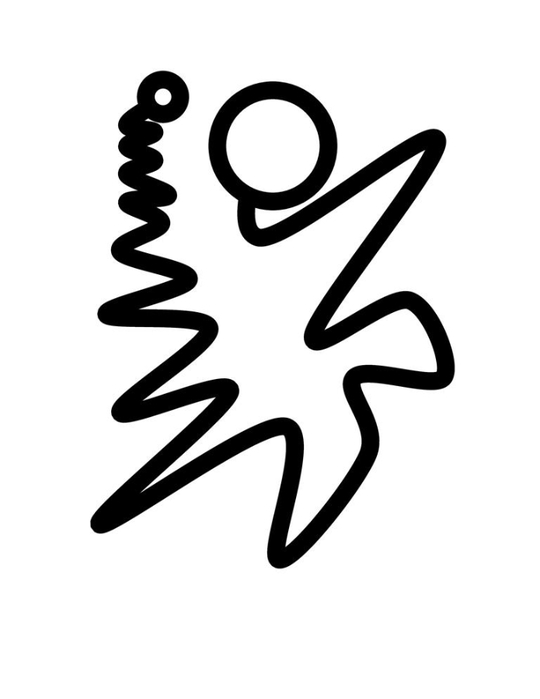
16.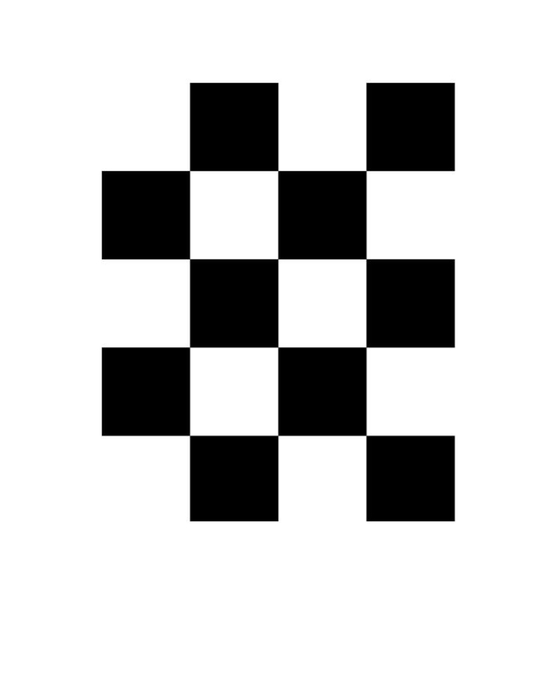
17.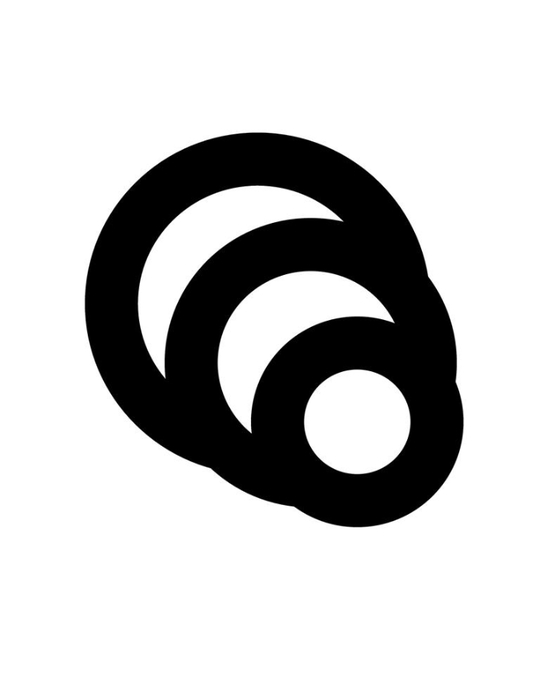
18.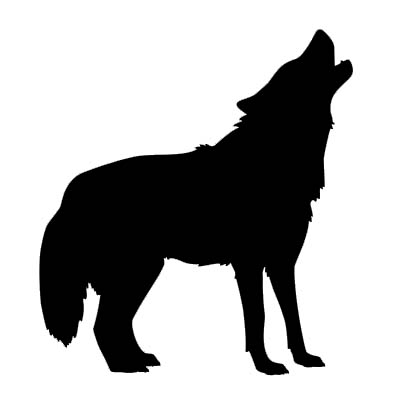
19.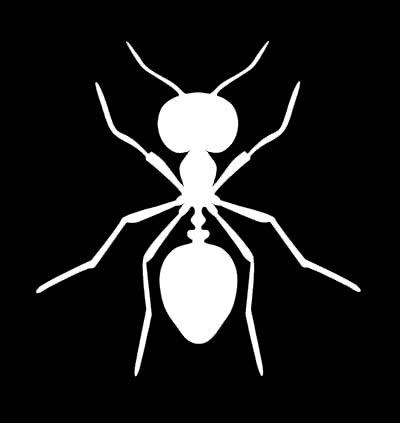
20.![]()
21.
22.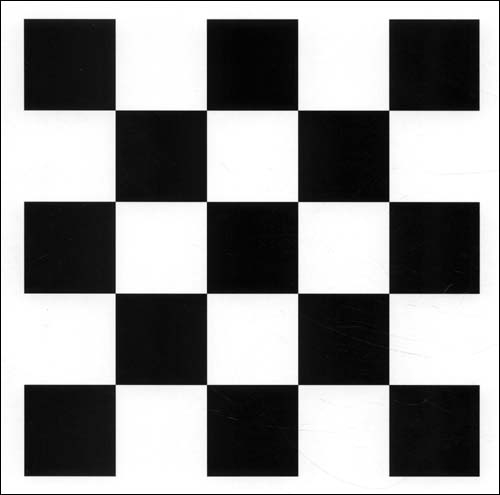
23.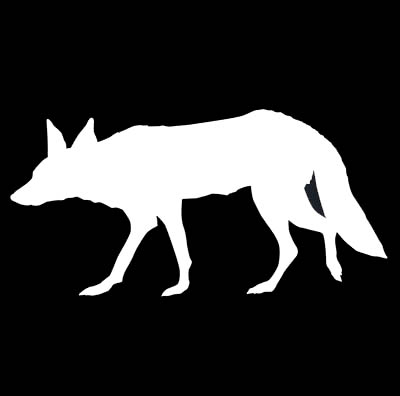
24.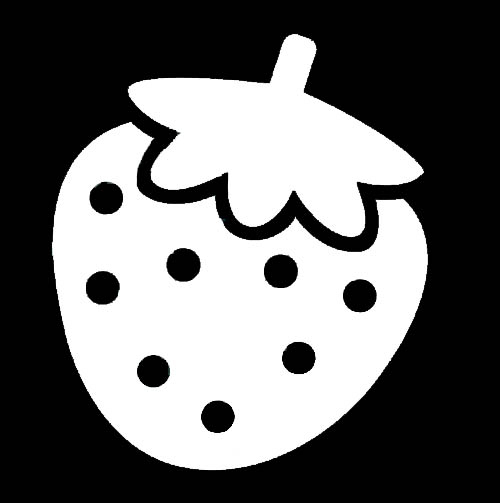
Pictures
Cited by
24459
Download black and white pictures for newborns. How to make a mobile from cubes for a child with your own hands and how to properly deal with printouts.
Black and white pictures for newborns perfectly stimulate the development of vision in the first months of life. Such gurus wrote about them early development like Cecile Lupan and Sarah Brewer in their book SuperChild. In the first days of life, the vision of a child is not as sharp as that of an adult. It distinguishes objects better at close range, and black-and-white images are more noticeable than color ones due to the structural features of the retina of the eye during this period.
The period from birth to six months is very important for the development of a child's vision, because it is during this period that the eyeball, the pathways leading from it to the brain, and the brain regions responsible for receiving and processing visual information are most rapidly and intensively formed.
Psychophysiologists speak of this period as critical for the formation of the visual system. It is the first 6 months of a child's life that are most favorable for external stimulation and development of the visual system. As a result of such exercises, visual functions are significantly improved: light perception, visual acuity, color perception, contrast sensitivity, field of vision.
Classes can be carried out on a changing table, in a crib, on a bed, etc., but it is better that the light source is behind the baby's head.
Start with the simplest lines and keep a sharp black / white contrast.
In the first months, it is important to teach your child to look at pictures, focus vision, and follow objects.
Where to hang black and white pictures
- in the crib,
- stick on the walls,
- hang on the fridge,
- into large cubes,
- make cards, collages or a book, show them to the baby one by one,
- a ball or mobile over a bed with drawings,
- developmental mat.
How to use black and white pictures for newborns
Show the baby pictures while you walk around the apartment with him, feed him or put him on his tummy. The visually rich space (and constant visual stimulation) has a direct connection with the restful sleep of the baby.
Do not show the crumb too much pictures right away and watch the reaction. If he does not focus his gaze on the drawing and does not show interest in him at all - do not be discouraged (everything has its time).
Train tracking: we catch a glance at the picture and move it slowly left and right, up and down, then over time we complicate the trajectory: along an arc, diagonally, in a circle.
Use while lying on the bait and crawling. The kid tries to raise his head higher and higher, and it will be interesting for him to see something there that catches the eye.
Attract and switch attention, calm down.
Changeimage can every 3 days... If you like the picture, you can leave it for a longer time.
Distance from the child's eyes to the aged image 10 days - 1.5 months - about 30 cm ... The size of the pictures is better than A4 or A5 (a quarter of it).
From 3 months on, the images can be replaced with color, complex and “hygienically clean” - the baby will start dragging them into his mouth.
How to do:
- You can draw any pictures by hand.
- Make a mobile with your own hands from cubes. We print pictures from pdf file(there already ready layout for cubes), cut it out, glue it in the form of cubes, hang it on a ribbon (then it's your imagination).
I made two toys for toddler from 10 cubes. I printed it on medium-thick photographic paper, it turned out to be glossy and very beautiful) They hold even without glue, but nevertheless, for strength it is worth gluing. 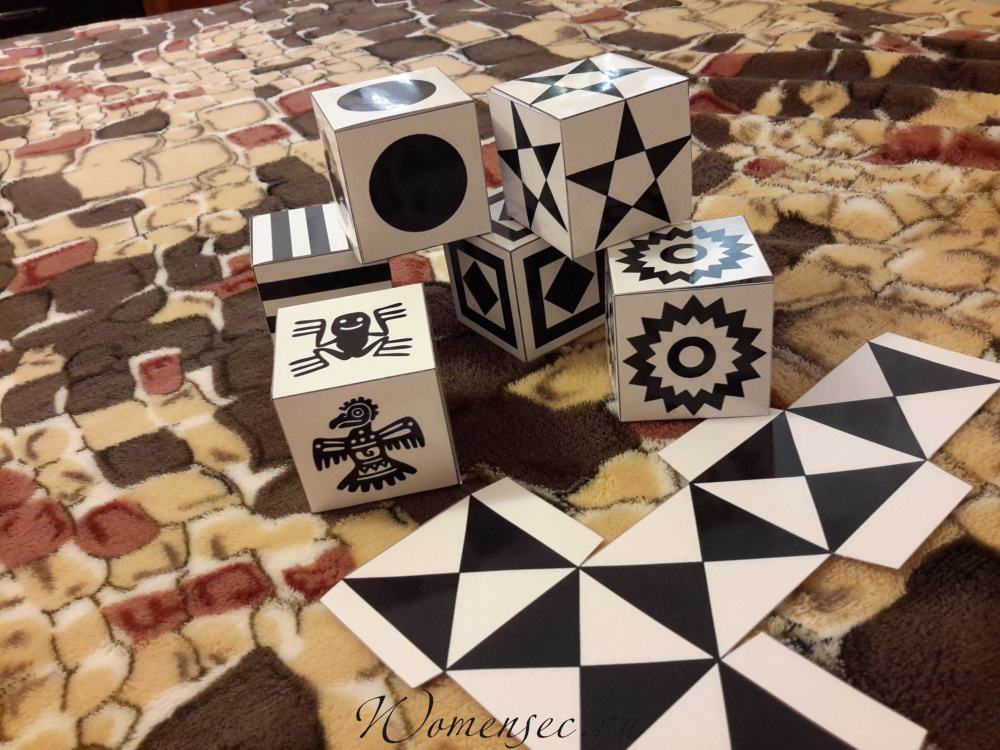
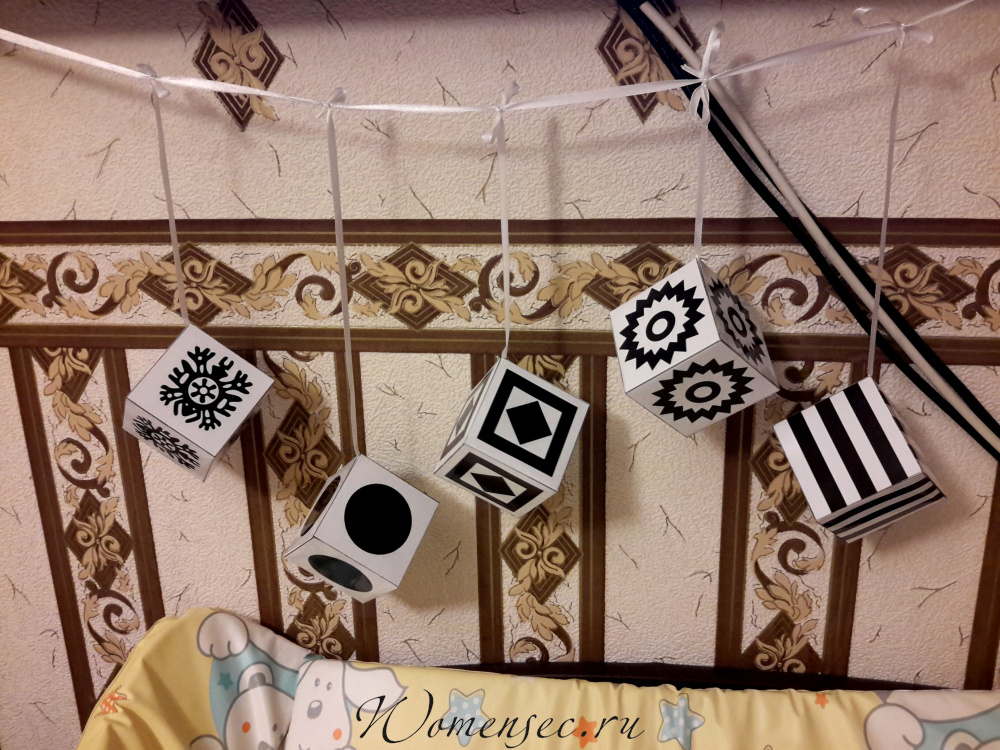
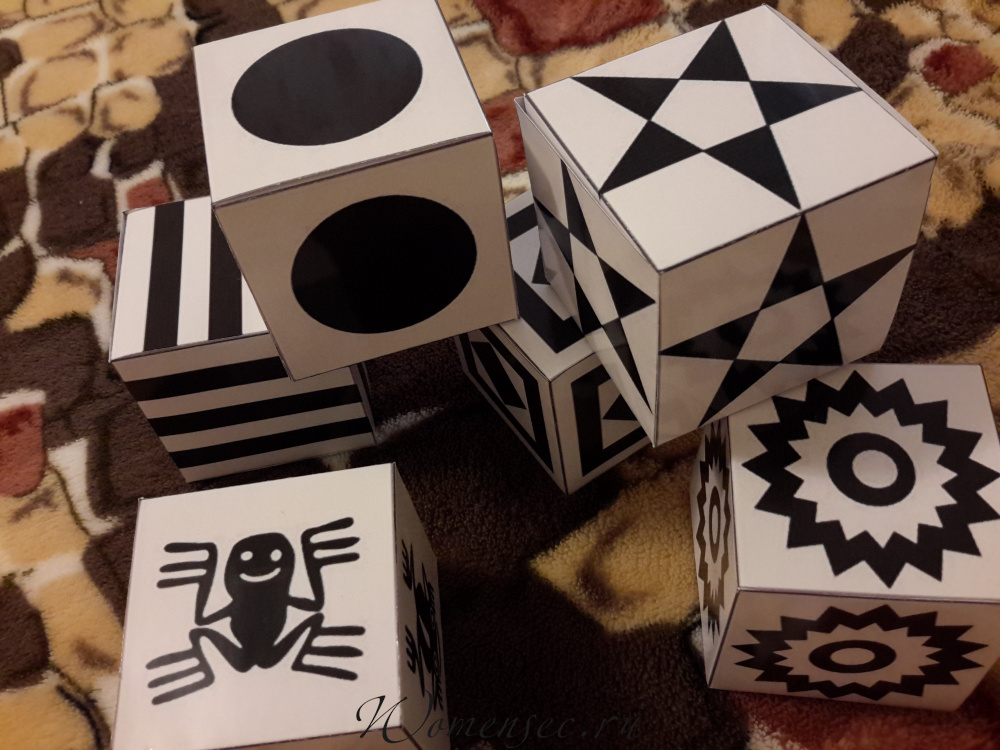
Why does a baby need black and white images
“Babies in their first two months of life are still learning to focus and are best able to distinguish high-contrast images. Among others, they prefer wide stripes, circles, broken and wavy lines in black and white. Newborns see best at a distance of 25-30 cm. " - this is, in fact, a squeeze of facts about the development of vision in infants, which are given in almost all books for young mothers.
I read all this before the very birth and made cards even before the birth of my second child. What can I do, I love all kinds of cards. With my first daughter, we skipped the "black and white" stage. Panic "develop, develop, develop!" I then started at about 3 months old, and I decided to start with the colored ones right away.
You can download my collection of black and white pictures for babies (there is a lot of everything), as well as from the Vkontakte project group.
So, I prepared cards with the contours of animals (as it turned out, "for growth": little is clear to the newborn), I made cubes with a black and white ornament. Some of them were attached to the mobile (I removed the "native" pendants for a while), the rest were also supplied with ribbons so that you could just put them on top of each other and hang them somewhere.
Finally, I remembered that I have a wonderful magazine of the publishing house "Karapuz" with geometric patterns for kids, and I printed the cards from there. By the way, they turned out to be the most demanded in our country.
In all books, it is advised to place all this wealth in the crib, at a comfortable distance for the baby (these same 25-30 cm). With the eldest, I remember, I still tried to measure something with a ruler, but even then I was convinced that many of the recommendations from the books are far from reality. And one of them is that the baby is not in the crib. Therefore, we had a portable cradle for looking at the pictures, which most often ends up in the kitchen (mom needs to cook, feed the rest of the household and eat herself) or in the nursery (mom needs to entertain her older sister). 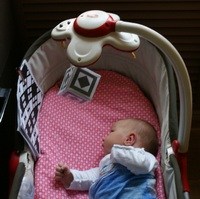
By the way, the mobile soon moved to the kitchen too. The kid agrees to lie alone longer if there are other people nearby. And the bed is used only when I have something to do in the bedroom itself - where it is located, or when I read an older book at night (we all sleep in the same room).
Where to use, where to attach
By the way, it is easiest to attach pictures to the bed: you can stick it with tape on the crossbars or hang it on a side sheet bent in half.
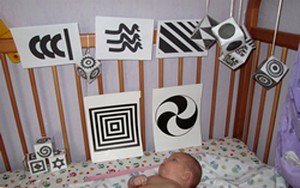
You shouldn't hang as many pictures as in the photo, I figured out how to look more conveniently, well, I photographed one behind one. In the future, I plan to stick with tape not the pictures themselves, into several transparent A4 and A5 files, and insert cards there, so that it is convenient to change the exposure.
When the baby and I walk around the apartment, special pictures for viewing are hidden in several more places: in the hall, on the TV wall (just at the level of the child's eyes when he is on the arms), in the kitchen, in the nursery.
At first, I leaned them against the side of the cradle, and put the baby on its side. When he grew up a little, I thought for a long time how to place them in the kitchen so that they were kept in sight. I accidentally found a way out: I did not turn the freshly printed sheets (2 pictures per sheet) into double-sided cards, gluing the edges with tape, but simply bent it in half, and in this form the sheet hung very cool on the long handles of the kitchen set, just at the right level ... You can, probably, hang like this from tables, stools and chairs.
It was high time to write this - our Pasha liked the pictures with geometric patterns very much, he looked at them for a long time (his beloved ones quickly showed up), followed them with his eyes. In a month and a half I was already looking at the figures and silhouettes of animals with pleasure. 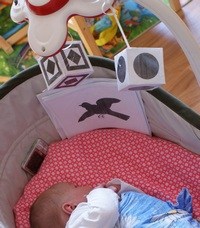
A little about cubes (with ribbons). We have them spinning on a mobile, suspended in a cradle and on a mat with arcs so that you can push with your hands, into a stroller while walking, they are placed in a pyramid when the baby is lying on his stomach. Eldest daughter, Irina loves to chat with them in front of the baby when communicating with him, and he sometimes catches them with a glance (she talks very quickly).
Some time later, I pasted the pictures on the box, I got a voluminous toy with six sides, everything - with different images... The main thing is that it is stable, you can put it in front of the lying baby anywhere. When the child's pictures ceased to be of interest, I pasted new ones on top. 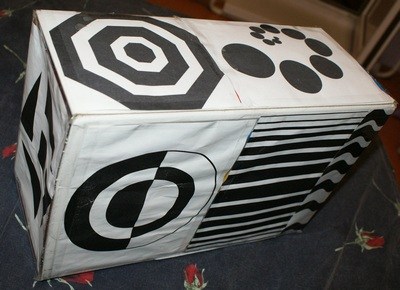
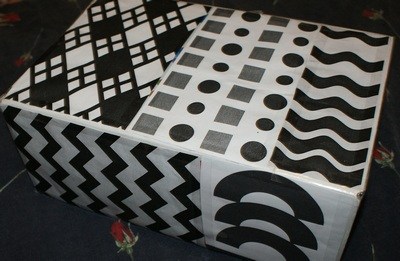
How to use?
So, what can you do with these cube cards, besides hanging them in places that are visible to the baby:
- Train tracking: we catch a glance at the picture and move it slowly left and right, up and down, then over time we complicate the trajectory: along an arc, diagonally, in a circle.
- Attract and switch attention, calm down. We have more than once managed to calm down the kid to "look, what a picture!". As you get bored, we show the next one.
- Use as exhibits when walking around the apartment in the hands of adults. When all the rooms have already been walked around 3 times in a day and everyone has looked, how to entertain the baby with new things? New pictures on the shelves, and not just black and white.
- Use while lying on your stomach and crawling. The kid tries to raise his head higher and higher, and it will be interesting for him to see something there that catches the eye (walls rarely fit, but if you lean a picture against them ...).
- Make it one of the means of showing care of the older child for the younger. Irina really likes to arrange pictures for Pasha. Even if he is in this moment she cannot see them (mom is doing gymnastics), she is happy that she took care of the baby.
Where to get?
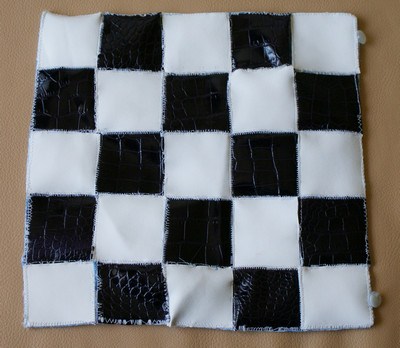
To do it yourself (options: draw with a black marker, paints, make an applique from dark and white paper, sew from fabric) - it would seem the easiest and cheapest way, but you need to start before the baby is born, after, in the first months, when, in fact, the materials and will be in demand, there may not be free time. The photo shows a part of our
Print ready. If there is where to print, the most suitable option for young parents, especially since the printing is budgetary, without color. Required files easy to find on the Internet, there are just a few sets walking around. You can download my collection of black and white pictures for babies (there is a lot of everything), as well as
More than 80% of information from the world around a person receives through sight. Therefore, for the full and harmonious development of a small child, it is necessary to stimulate his visual perception. The younger the child, the more intensively he learns. From birth, children need new experiences, food for brain development.
If the brain processes only sound stimuli, it does not work at full capacity, then it is very important to provide the child with the opportunity to see different objects as soon as possible. The child's vision develops gradually. Up to two to three months, he does not distinguish colors.
For this age, clear, contrasting black and white pictures are best suited, which are installed at a distance of 20-30 cm from the child's eyes. You can use them for as long as they like the child and arouse his interest.
Sarah Brewer's book Super Baby describes the role of black and white images in the development of babies between 0 and 3 months of age.
Excerpts from Sarah Brewer's Super Baby
 Vision plays a decisive role in the development of a child. Seeing various objects in front of him, the child wants to know what it is. The desire to reach for objects, crawl, roll over comes from natural curiosity and the desire to explore everything that the child sees around him. In the first two months of his life, he sees best at close range.
Vision plays a decisive role in the development of a child. Seeing various objects in front of him, the child wants to know what it is. The desire to reach for objects, crawl, roll over comes from natural curiosity and the desire to explore everything that the child sees around him. In the first two months of his life, he sees best at close range.
The field of vision of a newborn baby is more limited than that of an adult. Presumably, objects that are no further than 30 degrees to the left and right of him, 10 degrees above and below and at a distance not exceeding 90 cm from his eyes fall into the child's field of vision. When he suckles, he naturally focuses his vision on objects 15 to 20 cm away.
Usually, by two weeks, the baby begins to recognize the faces of the mother and father. His visual acuity is 10 to 30 percent less than that of an adult, so it is more difficult for him to recognize fine lines that he sees as a smeared gray mass. The retina of the human eye contains photoreceptors such as rods and cones. Rods are cells that are sensitive to weak light and movement and only distinguish shades of black and white.
Cones are cells that are responsible for daytime vision and allow you to see different colors and shades. Newborn babies like contrasting black and white designs more than color ones because at this age their rods perform better than cones. All other colors are seen by them as shades of gray.
Since black and white colors are most easily recognized by children, the use of black and white pictures stimulates the formation of connections between neurons in the cerebral cortex, develops attention, spurs children's natural curiosity and soothes during periods of overexcitation.
Also, newborns prefer straight or broken lines rather than curved or wavy lines. In addition, they are attracted by simple, schematic representations of human faces.
By the sixth week, the child can clearly focus on various objects at a distance of about 30 cm from him. He is especially attracted to simple images of faces and concentric circles in different versions. The child studies the outer edges of the drawings more closely than their middle.
The human brain is fully formed during intrauterine development. The number of neurons does not increase after birth, the brain develops due to the formation of new connections between neurons. The number of contacts between neurons in the area of the cerebral cortex responsible for visual information begins to gradually increase in the first 2 months after birth.
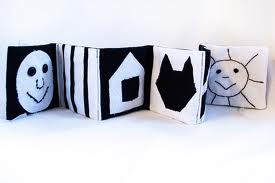 Between 2 and 4 months, the number of connections between neurons begins to grow sharply and increases by no less than 10 times. At this time, the child's eyesight improves dramatically, he can follow objects with his eyes and turn in the direction from which the sound comes. He begins to like more complex designs, rounded lines and shapes, rather than straight and broken lines. From the behavior of the child, you can see that he remembers what he saw.
Between 2 and 4 months, the number of connections between neurons begins to grow sharply and increases by no less than 10 times. At this time, the child's eyesight improves dramatically, he can follow objects with his eyes and turn in the direction from which the sound comes. He begins to like more complex designs, rounded lines and shapes, rather than straight and broken lines. From the behavior of the child, you can see that he remembers what he saw.
Many babies begin to distinguish colors by two months, because cones begin to work in the retina. But up to three months, they supposedly don't see blue as well as yellow or red.
 By the age of four months, the child can distinguish all colors and can focus his vision on both near and distant objects. He enjoys watching parents and other people, especially children. He still prefers curved lines to straight lines and pays attention to more complex designs. At 4 - 5 months, the child begins to reach for objects that he sees, at 7 - 8 months he can grab objects and try to put them in his mouth.
By the age of four months, the child can distinguish all colors and can focus his vision on both near and distant objects. He enjoys watching parents and other people, especially children. He still prefers curved lines to straight lines and pays attention to more complex designs. At 4 - 5 months, the child begins to reach for objects that he sees, at 7 - 8 months he can grab objects and try to put them in his mouth.
A child whose visual perception is constantly stimulated is usually more calm and alert while awake than a child without such stimulation.
The number of contacts between neurons in the visual cortex peaks at 8 months of age, remains at its maximum until four years of age, and gradually decreases by half over the next five years.
Consequently, binocular vision develops during the first four years of life and is fully developed by the age of four. Visual acuity is practically established by the age of five and is finally formed by the age of ten.
You can independently draw pictures on a white sheet of paper with a black bold marker, black gouache or ink, or print ready-made templates. Themes of the drawings:- geometric shapes (familiarity with shapes),
- emoticons (learning emotions),
- vegetables fruits,
- silhouettes of animals and insects (wildlife),
- just broken lines, punctuation marks, etc.
The sizes of the pictures can be different, from ¼ A4 to A4 (whole sheet), since the real objects that surround the child are also not the same in size. It will soon become clear which of them are more interesting for the child.
Pictures can be placed on cardboard boxes, on boxes of perfume, light bulbs, discs and cassettes, so that they can be conveniently placed in front of the child.
Pictures can be both flat (drawn on a sheet of paper) and voluminous (drawn on cylinders, cubes, etc.)
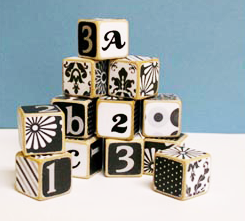 Cubes can be useful in the future, when the child grows up and will not just look at them, but play with them, learn letters and numbers from them.
Cubes can be useful in the future, when the child grows up and will not just look at them, but play with them, learn letters and numbers from them.
Pictures can be static (drawn) or moving, when cut black figures (stripes, circles, hearts, butterflies, etc.) are attached to the bar in front of a white background and move slightly from any light breath. Also, pictures can be placed in the form of an overlay on the side of a crib.
There are no specific recommendations when to move from the simplest pictures (squares, triangles, straight lines) to more complex ones. The child himself will make it clear what he is interested in, carefully examining some pictures and quickly skimming over others. It is not necessary to tape the pictures with tape, since they are intended for an age when children will not pull them into their mouths.
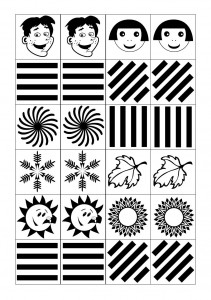 You can make a mobile (carousel), which is hung over the bed, from black and white pictures pasted on cardboard boxes. Some firms produce ready-made black and white toys (mobiles) and educational rugs. From four months you can replace black and white pictures on your mobile with color ones.
You can make a mobile (carousel), which is hung over the bed, from black and white pictures pasted on cardboard boxes. Some firms produce ready-made black and white toys (mobiles) and educational rugs. From four months you can replace black and white pictures on your mobile with color ones.
There are also black and white cartoons for babies Wee See, in which geometric shapes smoothly move across the screen and flow into each other to beautiful melodic music.
In addition to using the above pictures, the following visual exercises can be performed in the first three months of a child's life:
- Face-to-face communication: talking with a child at a distance of 25-30 cm, smiling at him, making "faces";
- Keep the rattle at the level of the child's eyes at a distance of 25-30 cm and slowly move it from side to side;
- Carry your baby around the house as often as possible so that he looks around.